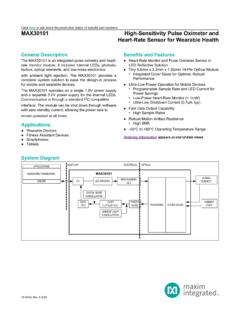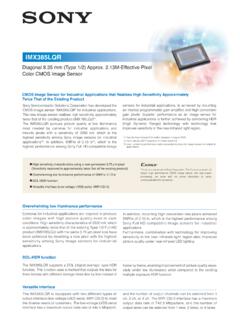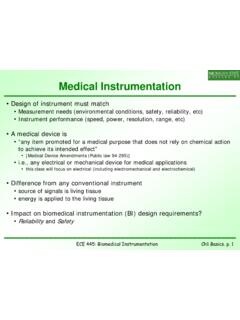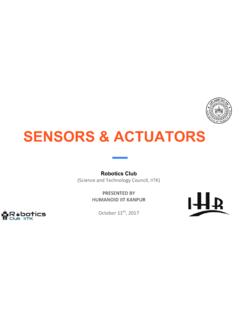Transcription of The Fundamentals of Camera and Image Sensor Technology
1 The Fundamentals of Camera and Image Sensor Technology Jon Chouinard Sales Manager, Eastern Region Baumer Ltd. Digital Cameras: Basic Course Light Basics + CCD/CMOS Imager Fundamentals Digital Camera Principals Interfaces Camera Types and When to Use Light and CCD/CMOS Sensor Fundamentals Light Basics CCD and CMOS Sensors Digital Camera Principals Camera Interface Standards Camera Types and When to Use Digital Cameras: Basic Course Electromagnetic Spectrum Light is a very narrow band in the electromagnetic spectrum Light Basics Light Spectrum We are primarily interested in wavelengths from 200 1100 nm Visible Light: 400 750 nm NUV: 200 400 nm NIR: 750 1100 nm Light Basics Light is represented as both a particle and an electromagnetic wave A light particle is called a photon.
2 Photons have some energy. (UV - > IR) The amount of energy determines the wavelength. The wavelength corresponds to a color. Intensity of light = number of photons. Light Basics E = Energy of Photon h = Planck's constant c = Speed of light = Wavelength of Light Photoelectric Effect: Photons to Electrons Light photons hitting a Silicon surface will dislodge electrons Number of electrons released depends on intensity and wavelength Silicon (+) Light Basics Quantum Efficiency (QE): The ratio of light that the Sensor converts into charge.
3 60% QE = For every 10 photons hitting a pixel, 6 electrons are released. QE response is Sensor specific. Camera design does not affect the QE curve. QE is given in either absolute or relative terms. Relative QE is not good for comparison. Light Basics The Full Well Capacity is the maximum number of electrons that register a signal in a pixel. Larger pixels have higher well capacity which also leads to higher sensitivity, better Signal to Noise Ratio (SNR), and increased dynamic range. Full Well Capacity: 4,000 electrons Small pixels 10,000 electrons Medium pixels 50,000 electrons Large pixels Light Basics Digital Cameras: Basic Course Light and CCD/CMOS Sensor Fundamentals Light Basics CCD and CMOS Sensors Digital Camera Principals Interfaces Camera Types and When to Use CCD and CMOS Sensors The main difference between CCD and CMOS is how they transfer the charge out of the pixel and into the Camera s electronics Read Out.
4 CCD CMOS Pixel: Read Out Circuitry: Current Voltage Sample CCD Sensor Think Bucket Brigade! CCD and CMOS Sensors CCD Sensor Charge-Coupled Device CCD imagers are Current Driven Devices Charge is collected in pixels The charge is then physically shifted on the imager surface to the output for sampling The CCD output is an analog pulse where the charge is proportional to the light intensity CCD and CMOS Sensors Microlens Microlenses increase the photon collection area of the pixel and focus
5 The photons into the photosensitive area (Good Fill Factor ) Almost all modern CCD designs use microlenses (Color & Monochrome ) PRO - Effectively increases the quantum efficiency of the pixel CON Creates and angular sensitivity to the incident light ray CCD Pixel with microlens CCD Sensor CCD focal plane Center rays Peripheral rays Lens Pixels Optical axis Angle to optical axis Microlenses decrease sensitivity to angular rays Angular QE data for Kodak KAI 0340 CCD Varies due to the photosensitive area not being square!
6 CCD and CMOS Sensors Pixel Out Horizontal Shift-Register Horizontal lines are shifted down the Sensor . Pixels are read out from a horizontal shift register through a common circuit Main Advantage: Sensitivity, CMOS is surpassing Fidelity Main Disadvantage Speed *CCD: Charge-Coupled Device CCD Imager CCD and CMOS Sensors Blooming is known as the spread of charges to adjacent pixels due to over saturation of pixels. This makes some very bright spots in the Image . CCD Issues: Blooming CCD and CMOS Sensors Smear is similar to blooming.
7 It s caused by pixels becoming saturated, and light spilling over into the vertical shift register while clocking out CCD Issues: Smearing CCD and CMOS Sensors CMOS Sensor Complimentary Metal-Oxide Semiconductor CMOS imagers are Voltage Driven Devices Light striking the pixel creates a voltage proportional to intensity The voltage is sampled directly at the pixel, digitized on the imager and cleared for the next frame (picture) The CMOS imager has a completely digital output CCD and CMOS Sensors CMOS layer stack up prevents using microlens and has lower charge conversion than CCD, usually resulting in lower sensitivity.
8 Higher Image non uniformities (aka Fixed Pattern Noise ) due to unevenness between the individual Pixel cells and multiple A/D circuits in column readout. CMOS is more resistant to Smearing or Blooming than a CCD! CMOS Issues: Pattern Noise + Sensitivity CCD and CMOS Sensors Voltage sampling is faster than rolling charge in CCD. This makes readout faster than CCD Less flow of charge = Less power Main Advantages: Speed + Power Consumption Sensitivity in newer sensors Main Disadvantages: Pattern Noise Sensitivity (older sensors) CMOS Sensor CCD and CMOS Sensors An electronic shutter (CCD) or global shutter (CMOS) allow exposure of the whole frame at the same time.
9 A rolling shutter will expose the frame line after line. The number of exposures equals the number of lines in the frame. CMOS Issues: Rolling Shutter Image taken with global shutter Image taken with rolling shutter CCD and CMOS Sensors total running time 1st row of AOIH2nd row of AOIH last row of AOIH start of integrationend of integrationeffective integration s@ 40 MHzFlash-Windowtime of flashCMOS Issues: Rolling Shutter A strobe can be used to help freeze the motion and minimize rolling shutter effects CCD and CMOS Sensors Move Move Distorting caused by a rolling shutter Picture taken from a moving car.
10 The railing in front has vertical bars. Note that the vertical bars are shown distorted caused by the rolling shutter. The actual shutter setting is short enough to freeze the movement. Image example showing distortion caused by a rolling shutter Image example with a moving object taken with global shutter. CMOS Issues: Rolling Shutter CCD and CMOS Sensors Progressive and Interlaced Scanning Image from Camera is formed by sequence of pixel lines scanned and displayed in one of two different ways. Progressive scanning : Scanning of first line, second line, third line, until the entire frame is scanned.









